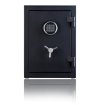Having a home safe is the best choice to protect belongings and important documents. However, like any other item, a home safe requires regular care and maintenance to ensure its longevity and optimal function. This article will provide some basic tips for maintaining and caring for the safe.
Tips for maintaining and caring for safe
With a few simple steps, people can keep their safe looking its best for years.
- Regular cleaning: Dust and debris can build up inside the safe over time, affecting the safe’s performance. Use a soft cloth or brush to clean the outside and inside of the safe regularly. Avoid using items or corrosive chemicals that could damage the finish or locking mechanism. A gentle cleaning process will help maintain the pristine condition of the safe and prevent any potential problems.
- Lubrication: Lubricating the lock cylinder mechanism is essential to ensure smooth operation. Use a non-greasy lubricant, such as silicone spray or graphite powder, and apply it carefully to the moving parts of the lock cylinder. Be careful not to over-lubricate, as over-lubrication will attract dirt and debris, which may affect the performance of the locking mechanism.
- Check Bolts: Equipment bolts or loose-leaf should be inspected periodically to ensure they function correctly. Test by locking and unlocking the safe, noting any rattles or resistance. If there are any problems, such as misaligned bolts or difficulty locking and unlocking, get in touch with professional after-sales for assistance as soon as possible.
- Maintain the best environment: The environment in which the safe is placed can determine the degree to which the safe is affected. The optimal setting for safe is in a dry and cool location away from direct sunlight or humid areas. Too much moisture can cause rust or corrosion, affecting the safe’s performance. If necessary, maintain an optimal environment with a dehumidifier or a product that absorbs moisture.
- Avoid Excessive Weight: While safes are designed to hold a certain amount of weight, it’s crucial not to overload them. Excessive weight can stress the safe’s structure and potentially damage it. If a security safe is installed, follow the manufacturer’s instructions to properly secure it to the floor.
- Regular Maintenance Checks: Conduct regular maintenance checks for the safe. This can be done annually or semi-annually, depending on the usage and the manufacturer’s recommendations. Have a professional locksmith inspect the safe, test its functionality, and fix any potential problems before some problems appear.
- Retaining Documents: All documents must be kept in a secure location concerning the safe. This includes the owner’s manual, warranty information, and maintenance or service records. If you need to contact the manufacturer or a professional locksmith for assistance, keep this information handy.
These maintenance and care tips can ensure the longevity and optimum performance of the room safe. Regular cleaning, lubrication, and inspections can help prevent potential problems and keep valuables safe. With proper care, a safe will continue to provide protection for years.
About AIFEIBAO
AIFEIBAO is a pioneer company with a history of 14 years in the safe field. Founded in 2009, the company has been at the forefront of providing cutting-edge solutions for secure safes. Over the years, the company has grown exponentially and now has a large workforce and global presence. We have a dedicated team of professionals and experts dedicated to providing innovative and reliable security products and services. At AIFEIBAO, we prioritize the safety and well-being of our clients, providing high-end technology for our customers in a rapidly evolving world. Visit our website at afbsafe.com to explore our comprehensive safety solutions.

Related articles:




























